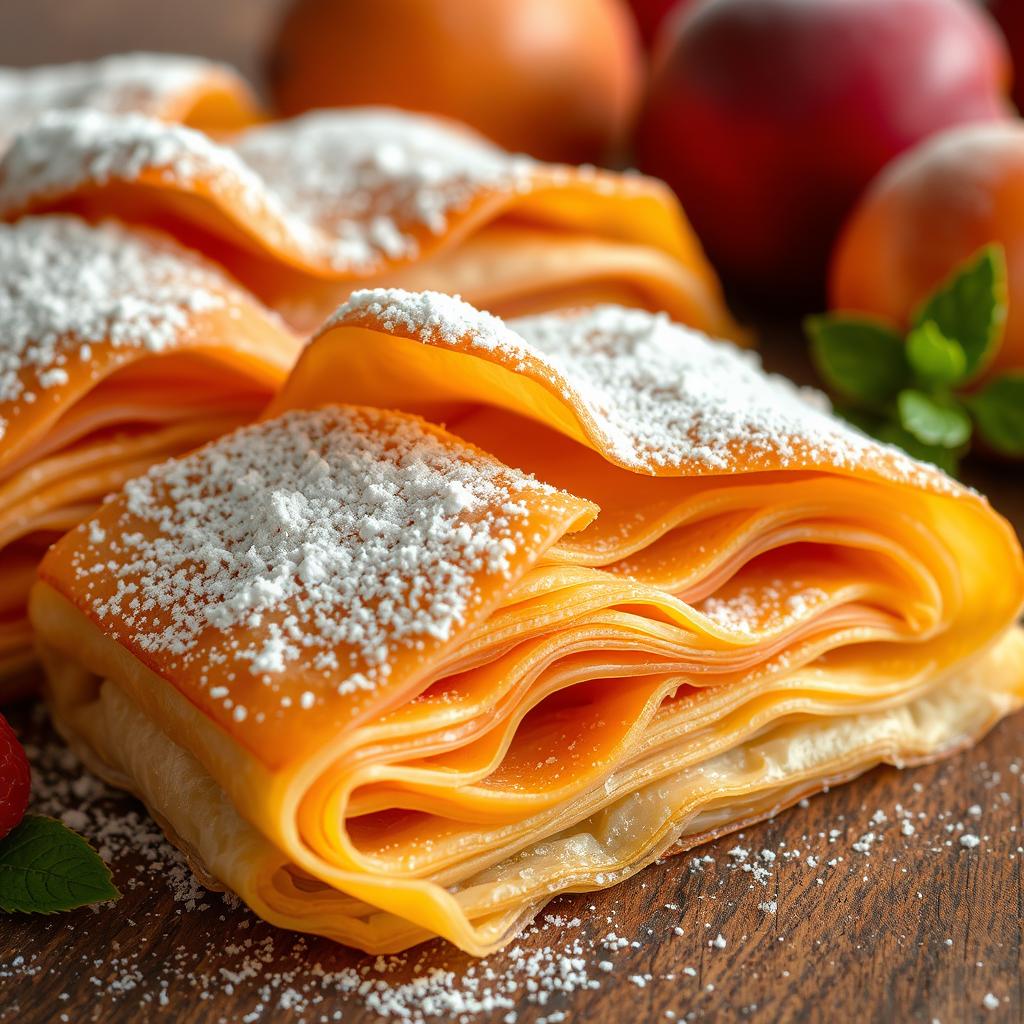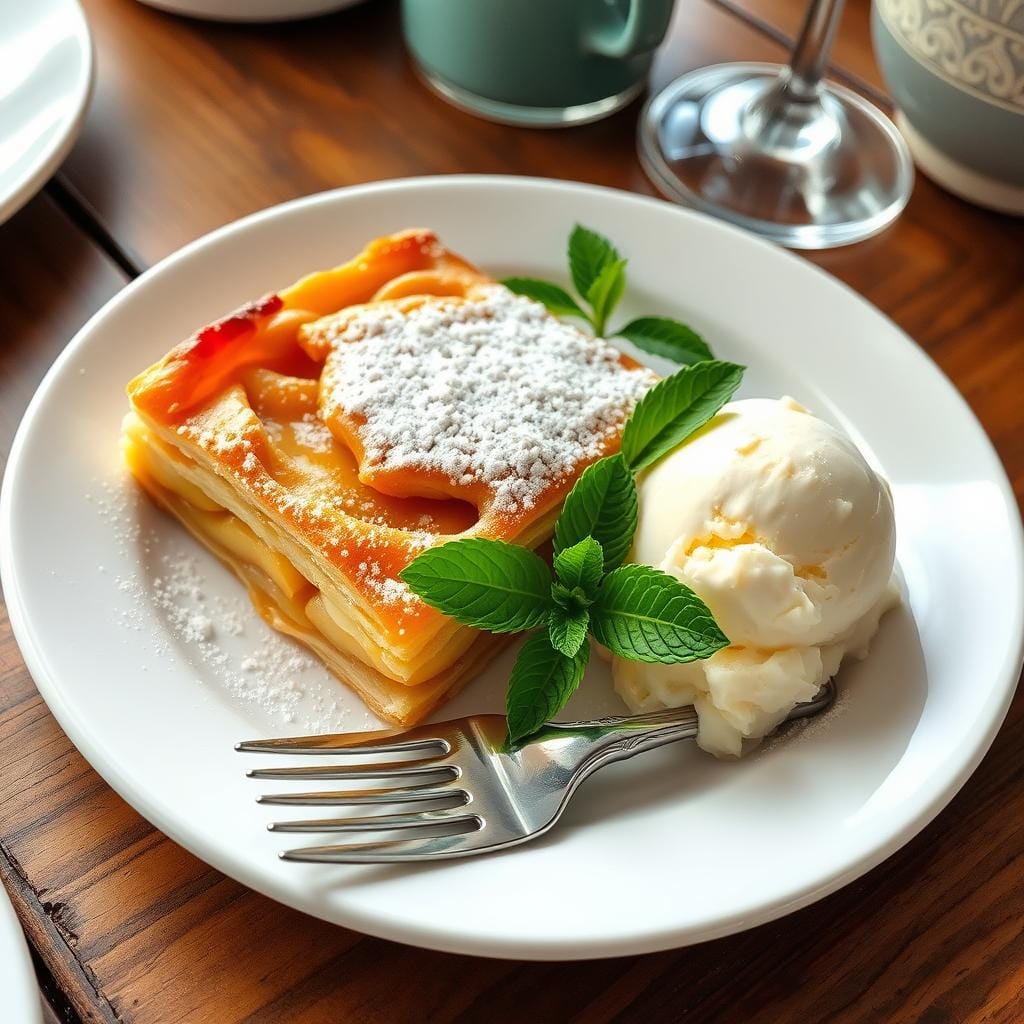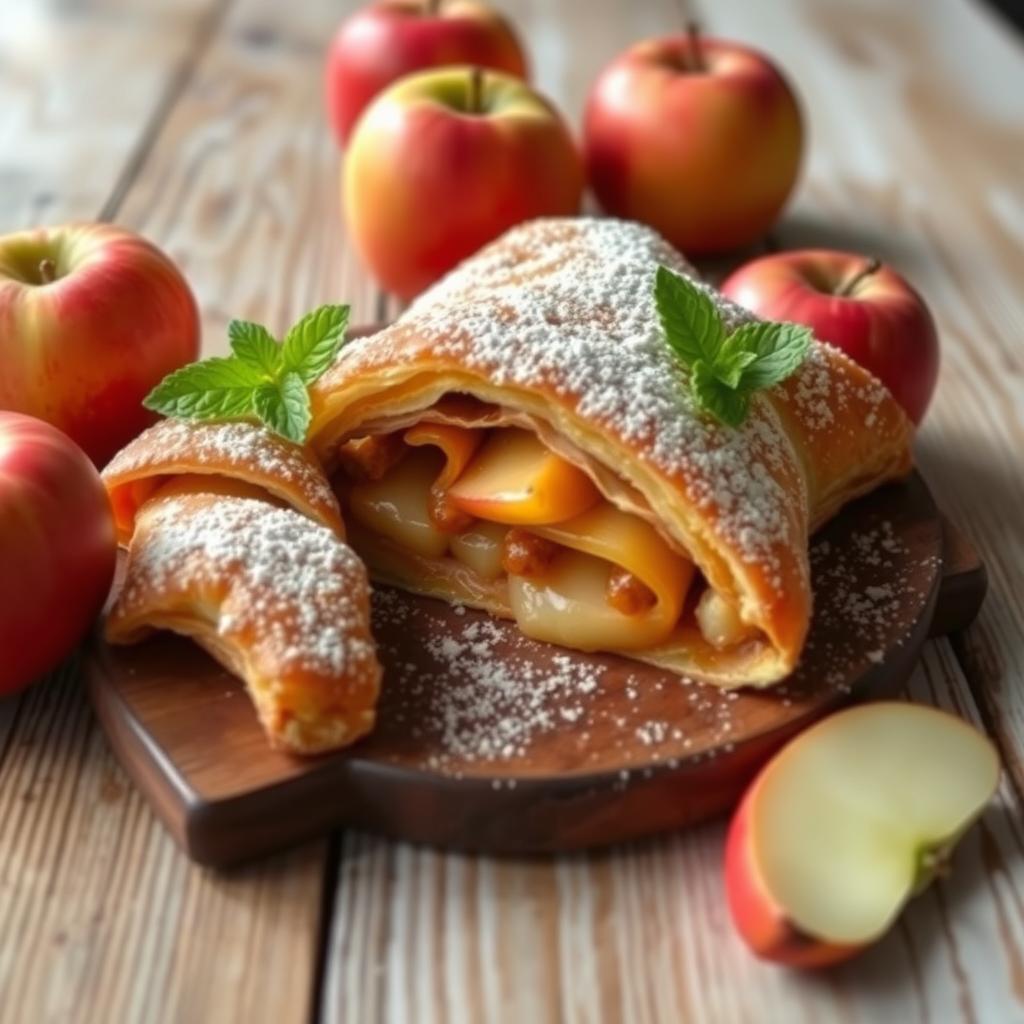Is strudel Austrian or German? The smell of strudel baking is irresistible, and it’s a favorite in both Austrian and German cuisine. But where did this delicious pastry originate? Let’s explore its history and cultural significance.
I grew up loving stories about food. The question of whether strudel is Austrian or German always fascinated me. I want to share what I’ve learned. It’s about the history and the cultural mix that made strudel so special.

Key Takeaways
- Strudel’s origins come from ancient Middle Eastern pastry traditions. It was influenced by many cultural exchanges in Europe.
- The debate on whether strudel is Austrian or German is complex. Both countries have strong ties to its history.
- The Habsburg Empire was key in strudel’s evolution. Vienna became a hub for pastry innovation, making it popular in royal courts.
- Traditional strudel-making, like stretching phyllo dough, has been kept alive through generations.
- Strudel is more than just food. It’s a big part of Viennese coffee house culture and family traditions.
The Ancient Origins of Strudel in European Cuisine
The delicious phyllo dough pastry we call strudel has a long history. It’s part of European cooking’s rich past. Exploring its origins, we find a story of cultural sharing and the growth of traditional baked goods.
Early Middle Eastern Influences on Pastry Making
The Middle East is where layered pastry-making started. Long before strudel, people in Persia and the Ottoman Empire made thin dough and layered it. These ideas traveled to Europe, helping create strudel and other flaky pastries.
The Evolution of Layered Pastries
- Trade routes helped share cooking skills, speeding up layered pastry’s growth in Europe.
- Greece, Turkey, and the Balkans improved these techniques, making treats like baklava and strudel famous.
- Phyllo dough pastry let bakers try many fillings, adding variety to pastries.
Historical Trade Routes and Cultural Exchange
Goods, people, and ideas moved along trade routes, spreading strudel and other traditional baked goods across Europe. Cities like Vienna, Budapest, and Munich were key in sharing cooking traditions. They helped shape strudel into the treat we love today.

“Strudel is not just a pastry; it’s a testament to the rich cultural tapestry that has woven its way through Europe for centuries.”
Is Strudel Austrian or German? The Historical Debate
The origins of strudel pastry have long been debated. Some say it’s a key part of viennese cuisine, while others believe it comes from german cuisine. Figuring out where strudel really comes from is important.
One side says strudel comes from Austria, linked to the Habsburg Empire. They point to its popularity in Viennese coffee houses and its cultural ties. They believe the pastry’s complex dough and fillings came from the imperial court and Viennese kitchens.
Others think strudel’s roots are in European pastry traditions. They say its layered design and ingredients are similar to pastries in Central and Eastern Europe. This view suggests strudel’s creation was shaped by culinary exchanges across the continent.
The debate on strudel’s origins is ongoing, with strong arguments on both sides. Its widespread appeal shows the rich history of European cuisine. Here, different cultures have mixed their traditions, creating beloved dishes like strudel.

The Habsburg Empire’s Role in Strudel’s Development
The origins of the iconic Austrian strudel go back to the Habsburg dynasty’s rule. The Habsburgs, ruling the Austro-Hungarian Empire, were key in strudel’s growth and spread. This viennese cuisine treat became a favorite around the world.
Vienna’s Contribution to Pastry Innovation
Vienna, the Habsburg court’s home, became a hub for food lovers. Pastry chefs in the imperial kitchens worked hard to make desserts for the european desserts elite. They perfected the austrian cuisine strudel’s taste and technique.
Royal Court Influences on Culinary Traditions
The Habsburg royal court’s love for pastry-making shaped viennese cuisine. Strudel, with its flaky dough and rich fillings, became a symbol of Austrian pride. The dessert’s many versions and serving traditions were kept alive, leaving a lasting mark on Austro-Hungarian food culture.
“Strudel is not merely a pastry – it is a testament to the cultural richness and culinary sophistication of the Habsburg Empire.”
Traditional Strudel Making Techniques
Making a real strudel pastry is an art that needs precision, patience, and a deep understanding of old ways. At the core of this delicate art is mastering phyllo dough pastry. This dough, made in thin layers, gives strudel its flaky texture.
Stretching the dough to the right thinness is a challenge for strudel makers. They use a special rolling pin and a big, clean area to stretch it. This careful process makes the dough almost see-through, showing the filling inside. It makes sure the flaky pastries are both delicate and strong, holding the filling well.
- Carefully roll and stretch the dough to achieve the desired thinness.
- Arrange the filling ingredients in a neat line along the edge of the dough.
- Gently roll the dough around the filling, taking care not to tear the delicate layers.
- Bake the strudel until the crust is golden brown and the filling is bubbling.
These traditional techniques make authentic strudel pastries special. They create a mix of textures and tastes that have won hearts for many years.
“The art of strudel-making is a testament to the patience and skill of the bakers who have perfected this time-honored craft.”
Key Ingredients That Define Authentic Strudel
At the heart of apple strudel and other phyllo dough pastry treats are special ingredients. Each part, from the flaky layers to the rich fillings, is key. They bring out the true flavors and textures that have won hearts for ages.
The Art of Phyllo Dough Preparation
Phyllo dough is the base of strudel, showing the skill of pastry chefs. It’s stretched and layered carefully, often by hand. This makes the dough crisp and ready for fillings.
It takes a lot of practice to get it right. The dough must be tender but strong enough to hold the fillings.
Traditional Filling Variations
- The classic apple strudel has a mix of tart apples, cinnamon, and sometimes nuts. It’s a perfect blend of tastes.
- Savory strudels can have spinach, feta, and herbs, or even meat and veggies. It shows how versatile this pastry can be.
- Some places use special ingredients, like Viennese ingredients in Viennese strudel. It’s a way to honor local traditions.
Regional Ingredient Differences
Ingredients in strudel change with the region, showing local tastes and what’s available. The core is flaky dough and a tasty filling. But fruits, nuts, and more can vary by place.
Looking into strudel’s regional ingredients is fun. It shows the wide range of this pastry. It’s a way to connect with the culinary history passed down through generations.
Regional Variations: From Vienna to Bavaria
The strudel is a key player in Austrian cuisine and German cuisine. It shows how different areas have made their own versions of this dessert. From Vienna’s fancy coffee houses to Bavaria’s cozy bakeries, each strudel tells a story of local tastes and traditions.
In Austria, the Viennese strudel is famous for its thin dough and sweet apple filling. It’s topped with cinnamon and powdered sugar. Served warm with whipped cream, it’s a treat for the taste buds.
In Germany’s Bavaria, the strudel is bigger and has a thicker crust. It can have apple, sweet cheese, or even spinach and feta inside. This strudel is a hearty meal or a tasty snack, showing Bavaria’s love for food.
| Strudel Variation | Region | Key Characteristics |
|---|---|---|
| Viennese Strudel | Vienna, Austria | Delicate phyllo dough, apple filling, cinnamon, powdered sugar |
| Bavarian Strudel | Bavaria, Germany | Heartier crust, diverse fillings (apple, cheese, spinach and feta) |
These differences highlight the strudel’s flexibility and the rich history of Austrian cuisine and German cuisine. Exploring these strudels, you’ll see how each one celebrates local tastes and heritage.
The Cultural Significance of Strudel in Austrian Cuisine
Strudel is a beloved treat in viennese cuisine and austrian cuisine. It’s more than just a dessert; it’s a symbol of Austrian culture and tradition. This traditional baked goods delights everyone who tries it.
Strudel in Modern Viennese Coffee Houses
Visiting a traditional Viennese coffee house is like stepping back in time. These places are the heart of viennese cuisine and austrian cuisine. The smell of coffee and the sight of strudel are irresistible.
People enjoy a warm slice of strudel with a cup of Viennese coffee. This tradition has been loved for many years.
Family Traditions and Recipe Preservation
Passing down strudel recipes is a big deal in Austrian families. Grandmothers teach their grandkids how to make strudel. This keeps the tradition alive.
Baking strudel together brings families closer. It’s a way to honor their culinary heritage.
| Strudel Filling Variations | Traditional Preparation Methods |
|---|---|
| Apple Strudel | Hand-stretching the dough |
| Poppy Seed Strudel | Rolling and layering the dough |
| Quark (Cottage Cheese) Strudel | Carefully filling and shaping the strudel |
| Walnut Strudel | Baking the strudel to golden perfection |
Strudel is deeply rooted in viennese cuisine and austrian cuisine. It’s loved in coffee houses and family kitchens. This traditional baked goods brings joy and a sense of belonging to Austrians.
German Strudel Traditions and Adaptations
Strudel is often linked to Austrian cuisine, but it’s also a big part of German food culture. German bakers have made their own versions, showing how versatile this European dessert can be.
In Bavaria, you’ll find Bayerischer Apfelstrudel. It has a flaky crust and apples, cinnamon, and lemon. This mix of flavors is a big part of Bavarian German cuisine. In northern Germany, you might try Quarkstrudel, with its creamy cheese filling.
German bakers are known for their dough-making skills. They stretch the strudel pastry to make it very thin. This way, their strudel is light and crisp, keeping the traditional taste alive.

